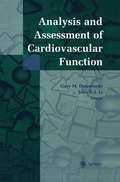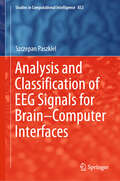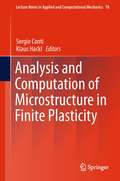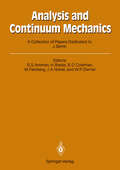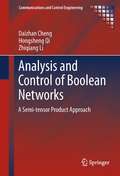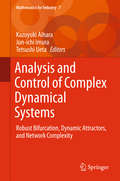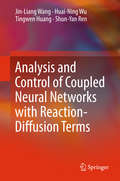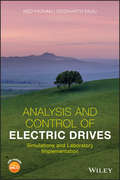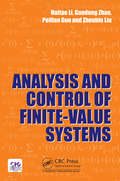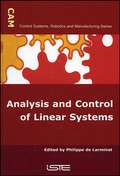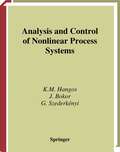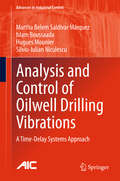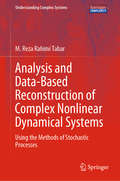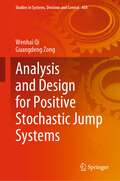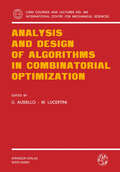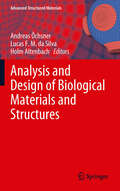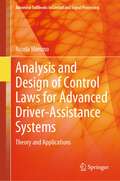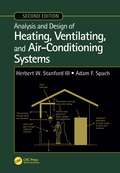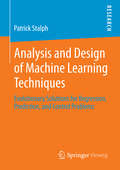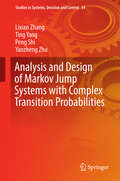- Table View
- List View
Analysis and Assessment of Cardiovascular Function
by Gary M. Drzewiecki John K. J. LiThe objective of this book is to provide the researcher and clinician with the recent developments in the analysis and assessment of cardiovascular func tion. The chapters are organized into sections that correspond with the various anatomical levels of the cardiovascular system. To a large extent, recent focus on the cardiovascular system function has been directed at the molecular level to the near exclusion of the tissue and organ function. While this may be useful in developing new therapeutic drugs, it does not aid the cardiologist or surgeon, who routinely deal with patient symptoms. This book integrates the micro-level and organ-level function so that new infor mation may be assimilated into the cardiovascular system as a whole. Within each section, the chapters have been arranged to progress from recent theoretical developments, to experimental research, and finally to clinical applications. This approach facilitates the timely transfer of infor mation from basic research to the clinic. The strength of the analytical approach will be evident to the reader. The theoretical analysis offers guidance to experimental design and, in some cases, offers solutions where measurements are as yet unattainable. In moving from newly attained knowledge to clinical practice, this book emphasizes the noninvasive meth in the future as technological advances ods. Such methods are desirable occur and the trend towards early preventive diagnosis is sought. What follows are highlights of new developments covered in each section of the book.
Analysis and Classification of EEG Signals for Brain–Computer Interfaces (Studies in Computational Intelligence #852)
by Szczepan PaszkielThis book addresses the problem of EEG signal analysis and the need to classify it for practical use in many sample implementations of brain–computer interfaces. In addition, it offers a wealth of information, ranging from the description of data acquisition methods in the field of human brain work, to the use of Moore–Penrose pseudo inversion to reconstruct the EEG signal and the LORETA method to locate sources of EEG signal generation for the needs of BCI technology. In turn, the book explores the use of neural networks for the classification of changes in the EEG signal based on facial expressions. Further topics touch on machine learning, deep learning, and neural networks. The book also includes dedicated implementation chapters on the use of brain–computer technology in the field of mobile robot control based on Python and the LabVIEW environment. In closing, it discusses the problem of the correlation between brain–computer technology and virtual reality technology.
Analysis and Computation of Microstructure in Finite Plasticity (Lecture Notes in Applied and Computational Mechanics #78)
by Sergio Conti Klaus HacklThis book addresses the need for a fundamental understanding of the physical origin, the mathematical behavior and the numerical treatment of models which include microstructure. Leading scientists present their efforts involving mathematical analysis, numerical analysis, computational mechanics, material modelling and experiment. The mathematical analyses are based on methods from the calculus of variations, while in the numerical implementation global optimization algorithms play a central role. The modeling covers all length scales, from the atomic structure up to macroscopic samples. The development of the models ware guided by experiments on single and polycrystals and results will be checked against experimental data.
Analysis and Continuum Mechanics: A Collection of Papers Dedicated to J. Serrin on His Sixtieth Birthday
by Martin Feinberg John A. Nohel William P. Ziemer Stuart S. Antman Haim Brezis Bernard D. ColemanThe 39 papers in this collection are devoted mostly to the exact mathematical analysis of problems in continuum mechanics, but also to problems of a purely mathematical nature mainly connected to partial differential equations from continuum physics. All the papers are dedicated to J. Serrin and were originally published in the "Archive of Rational Mechanics and Analysis".
Analysis and Control of Boolean Networks: A Semi-tensor Product Approach (Communications and Control Engineering)
by Daizhan Cheng Hongsheng Qi Zhiqiang LiAnalysis and Control of Boolean Networks presents a systematic new approach to the investigation of Boolean control networks. The fundamental tool in this approach is a novel matrix product called the semi-tensor product (STP). Using the STP, a logical function can be expressed as a conventional discrete-time linear system. In the light of this linear expression, certain major issues concerning Boolean network topology – fixed points, cycles, transient times and basins of attractors – can be easily revealed by a set of formulae. This framework renders the state-space approach to dynamic control systems applicable to Boolean control networks. The bilinear-systemic representation of a Boolean control network makes it possible to investigate basic control problems including controllability, observability, stabilization, disturbance decoupling etc.
Analysis and Control of Complex Dynamical Systems: Robust Bifurcation, Dynamic Attractors, and Network Complexity (Mathematics for Industry #7)
by Kazuyuki Aihara Jun-Ichi Imura Tetsushi UetaThis book is the first to report on theoretical breakthroughs on control of complex dynamical systems developed by collaborative researchers in the two fields of dynamical systems theory and control theory. As well, its basic point of view is of three kinds of complexity: bifurcation phenomena subject to model uncertainty, complex behavior including periodic/quasi-periodic orbits as well as chaotic orbits, and network complexity emerging from dynamical interactions between subsystems. Analysis and Control of Complex Dynamical Systems offers a valuable resource for mathematicians, physicists, and biophysicists, as well as for researchers in nonlinear science and control engineering, allowing them to develop a better fundamental understanding of the analysis and control synthesis of such complex systems.
Analysis and Control of Coupled Neural Networks with Reaction-Diffusion Terms
by Jin-Liang Wang Huai-Ning Wu Tingwen Huang Shun-Yan RenThis book introduces selected recent findings on the analysis and control of dynamical behaviors for coupled reaction-diffusion neural networks. It presents novel research ideas and essential definitions concerning coupled reaction-diffusion neural networks, such as passivity, adaptive coupling, spatial diffusion coupling, and the relationship between synchronization and output strict passivity. Further, it gathers research results previously published in many flagship journals, presenting them in a unified form. As such, the book will be of interest to all university researchers and graduate students in Engineering and Mathematics who wish to study the dynamical behaviors of coupled reaction-diffusion neural networks.
Analysis and Control of Electric Drives: Simulations and Laboratory Implementation
by Ned Mohan Siddharth RajuA guide to drives essential to electric vehicles, wind turbines, and other motor-driven systems Analysis and Control of Electric Drives is a practical and comprehensive text that offers a clear understanding of electric drives and their industrial applications in the real-world including electric vehicles and wind turbines. The authors—noted experts on the topic—review the basic knowledge needed to understand electric drives and include the pertinent material that examines DC and AC machines in steady state using a unique physics-based approach. The book also analyzes electric machine operation under dynamic conditions, assisted by Space Vectors. The book is filled with illustrative examples and includes information on electric machines with Interior Permanent Magnets. To enhance learning, the book contains end-of-chapter problems and all topics covered use computer simulations with MATLAB Simulink® and Sciamble® Workbench software that is available free online for educational purposes. This important book: Explores additional topics such as electric machines with Interior Permanent Magnets Includes multiple examples and end-of-chapter homework problems Provides simulations made using MATLAB Simulink® and Sciamble® Workbench, free software for educational purposes Contains helpful presentation slides and Solutions Manual for Instructors; simulation files are available on the associated website for easy implementation A unique feature of this book is that the simulations in Sciamble® Workbench software can seamlessly be used to control experiments in a hardware laboratory Written for undergraduate and graduate students, Analysis and Control of Electric Drives is an essential guide to understanding electric vehicles, wind turbines, and increased efficiency of motor-driven systems.
Analysis and Control of Electric Drives: Simulations and Laboratory Implementation
by Ned Mohan Siddharth RajuA guide to drives essential to electric vehicles, wind turbines, and other motor-driven systems Analysis and Control of Electric Drives is a practical and comprehensive text that offers a clear understanding of electric drives and their industrial applications in the real-world including electric vehicles and wind turbines. The authors—noted experts on the topic—review the basic knowledge needed to understand electric drives and include the pertinent material that examines DC and AC machines in steady state using a unique physics-based approach. The book also analyzes electric machine operation under dynamic conditions, assisted by Space Vectors. The book is filled with illustrative examples and includes information on electric machines with Interior Permanent Magnets. To enhance learning, the book contains end-of-chapter problems and all topics covered use computer simulations with MATLAB Simulink® and Sciamble® Workbench software that is available free online for educational purposes. This important book: Explores additional topics such as electric machines with Interior Permanent Magnets Includes multiple examples and end-of-chapter homework problems Provides simulations made using MATLAB Simulink® and Sciamble® Workbench, free software for educational purposes Contains helpful presentation slides and Solutions Manual for Instructors; simulation files are available on the associated website for easy implementation A unique feature of this book is that the simulations in Sciamble® Workbench software can seamlessly be used to control experiments in a hardware laboratory Written for undergraduate and graduate students, Analysis and Control of Electric Drives is an essential guide to understanding electric vehicles, wind turbines, and increased efficiency of motor-driven systems.
Analysis and Control of Finite-Valued Systems
by Haitao Li Guodong Zhao Peilian GuoA comprehensive work in finite-value systems that covers the latest achievements using the semi-tensor product method, on various kinds of finite-value systems. These results occupy the highest position in the analysis and control of this field. It not only covers all aspects of research in finite-value systems, but also presents the mathematical derivation for each conclusion in depth. The book contains examples to provide a better understanding of the practical applications of finite-value systems. It will serve as a textbook for graduate students of Cybernetics, Mathematical, and Biology, and a reference for readers interested in the theory of finite-value systems.
Analysis and Control of Finite-Valued Systems
by Haitao Li Guodong Zhao Peilian GuoA comprehensive work in finite-value systems that covers the latest achievements using the semi-tensor product method, on various kinds of finite-value systems. These results occupy the highest position in the analysis and control of this field. It not only covers all aspects of research in finite-value systems, but also presents the mathematical derivation for each conclusion in depth. The book contains examples to provide a better understanding of the practical applications of finite-value systems. It will serve as a textbook for graduate students of Cybernetics, Mathematical, and Biology, and a reference for readers interested in the theory of finite-value systems.
Analysis and Control of Linear Systems (Control Systems, Robotics, And Manufacturing Ser.)
by Philippe De LarminatAutomation of linear systems is a fundamental and essential theory. This book deals with the theory of continuous-state automated systems.
Analysis and Control of Linear Systems
by Philippe De LarminatAutomation of linear systems is a fundamental and essential theory. This book deals with the theory of continuous-state automated systems.
Analysis and Control of Nonlinear Process Systems (Advanced Textbooks in Control and Signal Processing)
by Katalin M. Hangos József Bokor Gábor SzederkényiThis straightforward text makes the complicated but powerful methods of non-linear control accessible to process engineers. Not only does it cover the necessary mathematics, but it consistently refers to the widely-known finite-dimensional linear time-invariant continuous case as a basis for extension to the nonlinear situation.
Analysis and Control of Oilwell Drilling Vibrations: A Time-Delay Systems Approach (Advances in Industrial Control)
by Martha Belem Saldivar Márquez Islam Boussaada Hugues Mounier Silviu-Iulian NiculescuThis book reports the results of exhaustive research work on modeling and control of vertical oil well drilling systems. It is focused on the analysis of the system-dynamic response and the elimination of the most damaging drill string vibration modes affecting overall perforation performance: stick-slip (torsional vibration) and bit-bounce (axial vibration). The text is organized in three parts.The first part, Modeling, presents lumped- and distributed-parameter models that allow the dynamic behavior of the drill string to be characterized; a comprehensive mathematical model taking into account mechanical and electric components of the overall drilling system is also provided. The distributed nature of the system is accommodated by considering a system of wave equations subject to nonlinear boundary conditions; this model is transformed into a pair of neutral-type time-delay equations which can overcome the complexity involved in the analysis and simulation of the partial differential equation model.The second part, Analysis, is devoted to the study of the response of the system described by the time-delay model; important properties useful for analyzing system stability are investigated and frequency- and time-domain techniques are reviewed.Part III, Control, concerns the design of stabilizing control laws aimed at eliminating undesirable drilling vibrations; diverse control techniques based on infinite--dimensional system representations are designed and evaluated. The control proposals are shown to be effective in suppressing stick-slip and bit-bounce so that a considerable improvement of the overall drilling performance can be achieved.This self-contained book provides operational guidelines to avoid drilling vibrations. Furthermore, since the modeling and control techniques presented here can be generalized to treat diverse engineering problems, it constitutes a useful resource to researchers working on control and its engineering application in oil well drilling.
Analysis and Control of Ultrafast Photoinduced Reactions (Springer Series in Chemical Physics #87)
by Oliver Kühn Ludger WösteThis book summarizes several years of research carried out by a collaboration of many groups on ultrafast photochemical reactions. It emphasizes the analysis and characterization of the nuclear dynamics within molecular systems in various environments induced by optical excitations and the study of the resulting molecular dynamics by further interaction with an optical field.
Analysis and Data-Based Reconstruction of Complex Nonlinear Dynamical Systems: Using the Methods of Stochastic Processes (Understanding Complex Systems)
by M. Reza Rahimi TabarThis book focuses on a central question in the field of complex systems: Given a fluctuating (in time or space), uni- or multi-variant sequentially measured set of experimental data (even noisy data), how should one analyse non-parametrically the data, assess underlying trends, uncover characteristics of the fluctuations (including diffusion and jump contributions), and construct a stochastic evolution equation?Here, the term "non-parametrically" exemplifies that all the functions and parameters of the constructed stochastic evolution equation can be determined directly from the measured data.The book provides an overview of methods that have been developed for the analysis of fluctuating time series and of spatially disordered structures. Thanks to its feasibility and simplicity, it has been successfully applied to fluctuating time series and spatially disordered structures of complex systems studied in scientific fields such as physics, astrophysics, meteorology, earth science, engineering, finance, medicine and the neurosciences, and has led to a number of important results.The book also includes the numerical and analytical approaches to the analyses of complex time series that are most common in the physical and natural sciences. Further, it is self-contained and readily accessible to students, scientists, and researchers who are familiar with traditional methods of mathematics, such as ordinary, and partial differential equations.The codes for analysing continuous time series are available in an R package developed by the research group Turbulence, Wind energy and Stochastic (TWiSt) at the Carl von Ossietzky University of Oldenburg under the supervision of Prof. Dr. Joachim Peinke. This package makes it possible to extract the (stochastic) evolution equation underlying a set of data or measurements.
Analysis and Design for Positive Stochastic Jump Systems (Studies in Systems, Decision and Control #450)
by Wenhai Qi Guangdeng ZongThe book focuses on analysis and design for positive stochastic jump systems. By using multiple linear co-positive Lyapunov function method and linear programming technique, a basic theoretical framework is formed toward the issues of analysis and design for positive stochastic jump systems. This is achieved by providing an in-depth study on several major topics such as stability, time delay, finite-time control, observer design, filter design, and fault detection for positive stochastic jump systems. The comprehensive and systematic treatment of positive systems is one of the major features of the book, which is particularly suited for readers who are interested to learn non-negative theory. By reading this book, the reader can obtain the most advanced analysis and design techniques for positive stochastic jump systems.
Analysis and Design of Algorithms in Combinatorial Optimization (CISM International Centre for Mechanical Sciences #266)
by Giorgio Ausiello M. LucertiniAnalysis and Design of Biological Materials and Structures (Advanced Structured Materials #14)
by Andreas Öchsner, Lucas F. M. F. M. Silva and Holm AltenbachThis collection provides researchers and scientists with advanced analyses and materials design techniques in Biomaterials and presents mechanical studies of biological structures. In 16 contributions well known experts present their research on Stress and Strain Analysis, Material Properties, Fluid and Gas mechanics and they show related problems.
Analysis and Design of Control Laws for Advanced Driver-Assistance Systems: Theory and Applications (Advanced Textbooks in Control and Signal Processing)
by Nicola MimmoAnalysis and Design of Control Laws for Advanced Driver-Assistance Systems (ADAS) teaches students how to solve classical problems in automotive control in a step-by-step fashion. It begins by motivating the use of ADAS and then explains different ADAS models and the goals of their control systems. Systems analysis and control architectures are presented, followed by a treatment of the use of optimal control and the Kalman filter. The author then presents more advanced control techniques and gives an overview of control problems involved in fully autonomous, hybrid and electric vehicles. Each chapter contains a specific discussion of its subject in terms of various ADAS functionalities, such as active suspension, power steering, lane control and automated parking. The text is developed by extensive use of worked examples, related to the applications discussed. Appendices, including necessary aspects of linear algebra and the use of MATLAB render the text self-contained. MATLAB files are provided to help both student and instructor model and analyse the systems being discussed. An electronic solutions manual is freely available for download by instructors adopting the book for their classroom teaching. This textbook will help final-year undergraduate and graduate students to understand the practical issues they will face when working on automotive systems in the real world and the theoretical underpinnings they will need to get to grips with the control systems of present and future generations of cars and other automotive transport. A basic grounding in mathematics and physics is all that is required to get the most from this text.
Analysis and Design of Heating, Ventilating, and Air-Conditioning Systems, Second Edition
by Herbert W. Stanford III Adam F. SpachAnalysis and Design of Heating, Ventilating, and Air-Conditioning Systems, Second Edition, provides a thorough and modern overview of HVAC for commercial and industrial buildings, emphasizing energy efficiency. This text combines coverage of heating and air conditioning systems design with detailed information on the latest controls technologies. It also addresses the art of HVAC design along with carefully explained scientific and technical content, reflecting the extensive experience of the authors. Modern HVAC topics are addressed, including sustainability, IAQ, water treatment and risk management, vibration and noise mitigation, and maintainability from a practical point of view.
Analysis and Design of Heating, Ventilating, and Air-Conditioning Systems, Second Edition
by Herbert W. Stanford III Adam F. SpachAnalysis and Design of Heating, Ventilating, and Air-Conditioning Systems, Second Edition, provides a thorough and modern overview of HVAC for commercial and industrial buildings, emphasizing energy efficiency. This text combines coverage of heating and air conditioning systems design with detailed information on the latest controls technologies. It also addresses the art of HVAC design along with carefully explained scientific and technical content, reflecting the extensive experience of the authors. Modern HVAC topics are addressed, including sustainability, IAQ, water treatment and risk management, vibration and noise mitigation, and maintainability from a practical point of view.
Analysis and Design of Machine Learning Techniques: Evolutionary Solutions for Regression, Prediction, and Control Problems
by Patrick StalphManipulating or grasping objects seems like a trivial task for humans, as these are motor skills of everyday life. Nevertheless, motor skills are not easy to learn for humans and this is also an active research topic in robotics. However, most solutions are optimized for industrial applications and, thus, few are plausible explanations for human learning. The fundamental challenge, that motivates Patrick Stalph, originates from the cognitive science: How do humans learn their motor skills? The author makes a connection between robotics and cognitive sciences by analyzing motor skill learning using implementations that could be found in the human brain – at least to some extent. Therefore three suitable machine learning algorithms are selected – algorithms that are plausible from a cognitive viewpoint and feasible for the roboticist. The power and scalability of those algorithms is evaluated in theoretical simulations and more realistic scenarios with the iCub humanoid robot. Convincing results confirm the applicability of the approach, while the biological plausibility is discussed in retrospect.
Analysis and Design of Markov Jump Systems with Complex Transition Probabilities (Studies in Systems, Decision and Control #54)
by Lixian Zhang Ting Yang Peng Shi Yanzheng ZhuThe book addresses the control issues such as stability analysis, control synthesis and filter design of Markov jump systems with the above three types of TPs, and thus is mainly divided into three parts. Part I studies the Markov jump systems with partially unknown TPs. Different methodologies with different conservatism for the basic stability and stabilization problems are developed and compared. Then the problems of state estimation, the control of systems with time-varying delays, the case involved with both partially unknown TPs and uncertain TPs in a composite way are also tackled. Part II deals with the Markov jump systems with piecewise homogeneous TPs. Methodologies that can effectively handle control problems in the scenario are developed, including the one coping with the asynchronous switching phenomenon between the currently activated system mode and the controller/filter to be designed. Part III focuses on the Markov jump systems with memory TPs. The concept of σ-mean square stability is proposed such that the stability problem can be solved via a finite number of conditions. The systems involved with nonlinear dynamics (described via the Takagi-Sugeno fuzzy model) are also investigated. Numerical and practical examples are given to verify the effectiveness of the obtained theoretical results. Finally, some perspectives and future works are presented to conclude the book.
